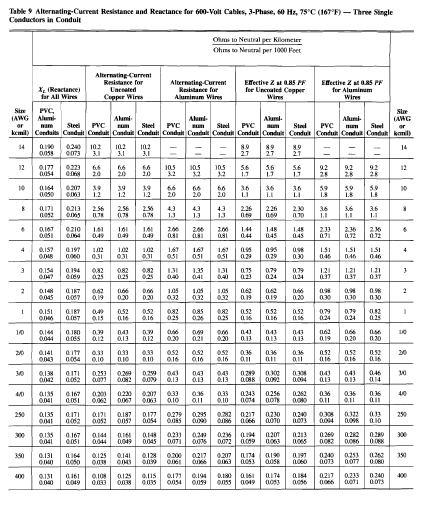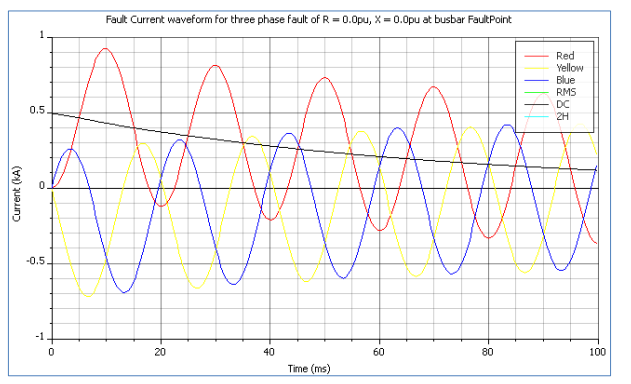How To Prepare Schedule of Loads
Schedule of load preparation is essential and a basic calculation for electrical engineers. In this process the proper sizing of conductors, overload protection and conduits are determined.
While there are different methods doing an electrical design but there is only one thing that cannot be altered --- code requirements must be followed.
- This example emphasized the procedure rather than mimicking the actual loads of a residential unit.
- In this example the voltage drop and short circuit calculation is not included.
- The system voltage of this example is 220 VAC, 60 Hz.
Schedule of Loads
|
Ckt |
Load |
Ph |
Rating Per outlet |
No. of Outlets |
VA |
Volts |
Amps |
Wire |
CB |
Cond. |
|
1 |
L.O. |
1 |
100 VA |
12 |
1,200 |
220 |
5.45 |
#14 TW |
15 AT, 1P |
½” dia. |
|
2 |
L.O. |
1 |
100 VA |
9 |
900 |
220 |
4.09 |
#14 TW |
15 AT, 1P |
½” dia. |
|
3 |
L.O. |
1 |
100 VA |
6 |
600 |
220 |
2.73 |
#14 TW |
15 AT, 1P |
½” dia. |
|
4 |
C.O |
1 |
180 VA |
10 |
1,800 |
220 |
8.18 |
#12 TW |
20 AT, 1P |
¾” dia. |
|
5 |
C.O |
1 |
180 VA |
12 |
2,160 |
220 |
9.82 |
#12 TW |
30 AT, 1P |
¾” dia. |
|
6 |
ACU |
1 |
2.5 HP |
1 |
2331 |
220 |
10.60 |
#10 TW |
30 AT, 1P |
¾” dia. |
|
7 |
ACU |
1 |
2.5 HP |
1 |
2331 |
220 |
10.60 |
#10 TW |
30 AT, 1P |
¾” dia. |
|
8 |
ACU |
1 |
2.5 HP |
1 |
2331 |
220 |
10.60 |
#10 TW |
30 AT, 1P |
¾” dia. |
|
9 |
Range Load |
1 |
5000 W |
1 |
5000 |
220 |
22.71 |
# 8 TW |
80 AT, 1P |
1.0” dia. |
Schedule of loads are just a summary of data to easily identify and facilitate the necessary values and equipment rating to be used in any electrical installation. Any data given in the schedule of loads were backed by calculation based on a well settled electrical principles and code requirements.
The general rule: The cable and circuit breaker must always be coordinated.
Computations
Circuit 1:
I = 1,200 VA/ 220 V = 5.45 Ampere
Wire = 5.45 / 80% = 6.82 Amperes , Use 2.0 sqmm TW wire or #14 AWG [1]
Circuit Breaker = Use 15 A Circuit Breaker
Conduit = Use 1/2" diameter PVC conduit.
Circuit 2:
I = 900 VA/ 220 V = 4.09 Ampere
Wire = 4.09/ 80%= 5.11 Amperes , Use 2.0 sqmm TW wire or #14 AWG
Circuit Breaker = Use 15 A Circuit Breaker
Conduit = Use 1/2" diameter PVC conduit.
Circuit 3:
I = 600 VA/ 220 V = 2.72 Ampere
Wire = 2.72/ 80%= 3.41 Amperes , Use 2.0 sqmm TW wire or #14 AWG
Circuit Breaker = 6.82 Amperes, Use 15 A Circuit Breaker
Conduit = Use 1/2" diameter PVC conduit.
Circuit 4:
I = 1,800 VA/ 220 V = 8.18 Ampere
Wire = 8.18/ 80%= 10.23 Amperes , Use 3.5 sqmm TW wire or #12 AWG
Circuit Breaker = Use 20 A CB
Conduit = Use 3/4" diameter PVC conduit.
Main Feeder
By inspection:
Continuous loads = 9,963 VA or 45.29 A @ 220V (lighting loads and ACU)
Non- Continuous = 8, 960 VA or 40.72 @ 220V (conv. outlet & range load)
Total Loads = 19, 923 VA
Main Feeder Current = (45.29 x 100% ) + (40.72 x 125%) = 96.19 Amperes [4]
Use 50 sqmm TW cable as main feeder or service entrance wire
Use 100 Ampere MCCB, 1 pole - 10 kAIC*
note: 10 kAIC is just an assumed value, we need short circuit calculation to determine the right specs of the OCPD to be used in this example
Rules Applied:
1. NEC 210-9a - Maximum to be served by branch circuit must not be less than 80% of the ampacity of the condutor
2. NEC 430 -22 = The size of the wire supplying motorized load shall not be less than 125% of the rated full load current of the motor.
3. NEC 430- 52 = The size of the branch circuit protection for motor loads shall not be greater than 250% of motor full load current for CB and 300% for non-time delay fuses on full voltage starting.
4. NEC 210-22(C) = Over-Current Protection Device shall be calculated as 100% of non-continuous load + 125% of the continuous load.
References:
1. National Electrical Code 2011 (Handbook)
2. General Electric Circuit Breaker Catalogue
Computations
Circuit 1:
I = 1,200 VA/ 220 V = 5.45 Ampere
Wire = 5.45 / 80% = 6.82 Amperes , Use 2.0 sqmm TW wire or #14 AWG [1]
Circuit Breaker = Use 15 A Circuit Breaker
Conduit = Use 1/2" diameter PVC conduit.
Circuit 2:
I = 900 VA/ 220 V = 4.09 Ampere
Wire = 4.09/ 80%= 5.11 Amperes , Use 2.0 sqmm TW wire or #14 AWG
Circuit Breaker = Use 15 A Circuit Breaker
Conduit = Use 1/2" diameter PVC conduit.
Circuit 3:
I = 600 VA/ 220 V = 2.72 Ampere
Wire = 2.72/ 80%= 3.41 Amperes , Use 2.0 sqmm TW wire or #14 AWG
Circuit Breaker = 6.82 Amperes, Use 15 A Circuit Breaker
Conduit = Use 1/2" diameter PVC conduit.
Circuit 4:
I = 1,800 VA/ 220 V = 8.18 Ampere
Wire = 8.18/ 80%= 10.23 Amperes , Use 3.5 sqmm TW wire or #12 AWG
Circuit Breaker = Use 20 A CB
Conduit = Use 3/4" diameter PVC conduit.
Read: What are the Different Electric Current Symbols According to IEC Standard
Circuit 5:
I = 2,160 VA/ 220 V = 9.82 Ampere
Wire = 9.82/ 80% = 12.27 Amperes , Use 3.5 sqmm TW wire or #12 AWG
Circuit Breaker = Use 20 A CB
Conduit = Use 3/4" diameter PVC conduit.
Circuit 6-8:
VA = [ 2.5 HP x ( 746 Watts/ HP ) ] / 0.8 pf (assume 0.8 pf)
VA = 2331 VA
I = 2,331 VA/ 220 V = 10.60 Ampere
Wire = 10.60 x 125% = 13.24 Amperes , Use 3.5 sqmm TW wire or #12 AWG [2]
Circuit Breaker = 5.45 x 250% = 26.5 Amperes, Use 30 A Circuit Breaker [3]
Conduit = Use 3/4" diameter PVC conduit.
Note: since the breaker is 30 Ampere, we need to increase the cable size to 5.5 sqmm (rated 30 amps by NEC ) to maintain the coordination of cable and the circuit breaker.
Circuit 9:
VA = 5000 W / 1.0 pf (heating load is a resistive load w/ 100% pf)
VA = 5,000 VA
I = 5, 000 VA/ 220 V = 22.72 Ampere
Wire = 22.71 / 80% = 28.41 Amperes , Use 8.0 sqmm TW wire or #8 AWG
Circuit Breaker = Use 40 A Circuit Breaker
Conduit = Use 1.0" diameter PVC conduit.
Circuit 5:
I = 2,160 VA/ 220 V = 9.82 Ampere
Wire = 9.82/ 80% = 12.27 Amperes , Use 3.5 sqmm TW wire or #12 AWG
Circuit Breaker = Use 20 A CB
Conduit = Use 3/4" diameter PVC conduit.
Circuit 6-8:
VA = [ 2.5 HP x ( 746 Watts/ HP ) ] / 0.8 pf (assume 0.8 pf)
VA = 2331 VA
I = 2,331 VA/ 220 V = 10.60 Ampere
Wire = 10.60 x 125% = 13.24 Amperes , Use 3.5 sqmm TW wire or #12 AWG [2]
Circuit Breaker = 5.45 x 250% = 26.5 Amperes, Use 30 A Circuit Breaker [3]
Conduit = Use 3/4" diameter PVC conduit.
Note: since the breaker is 30 Ampere, we need to increase the cable size to 5.5 sqmm (rated 30 amps by NEC ) to maintain the coordination of cable and the circuit breaker.
Circuit 9:
VA = 5000 W / 1.0 pf (heating load is a resistive load w/ 100% pf)
VA = 5,000 VA
I = 5, 000 VA/ 220 V = 22.72 Ampere
Wire = 22.71 / 80% = 28.41 Amperes , Use 8.0 sqmm TW wire or #8 AWG
Circuit Breaker = Use 40 A Circuit Breaker
Conduit = Use 1.0" diameter PVC conduit.
Read: How to Select Proper Type of Miniature Circuit Breakers MCBs
Main Feeder
By inspection:
Continuous loads = 9,963 VA or 45.29 A @ 220V (lighting loads and ACU)
Non- Continuous = 8, 960 VA or 40.72 @ 220V (conv. outlet & range load)
Total Loads = 19, 923 VA
Main Feeder Current = (45.29 x 100% ) + (40.72 x 125%) = 96.19 Amperes [4]
Use 50 sqmm TW cable as main feeder or service entrance wire
Use 100 Ampere MCCB, 1 pole - 10 kAIC*
note: 10 kAIC is just an assumed value, we need short circuit calculation to determine the right specs of the OCPD to be used in this example
Rules Applied:
1. NEC 210-9a - Maximum to be served by branch circuit must not be less than 80% of the ampacity of the condutor
2. NEC 430 -22 = The size of the wire supplying motorized load shall not be less than 125% of the rated full load current of the motor.
3. NEC 430- 52 = The size of the branch circuit protection for motor loads shall not be greater than 250% of motor full load current for CB and 300% for non-time delay fuses on full voltage starting.
4. NEC 210-22(C) = Over-Current Protection Device shall be calculated as 100% of non-continuous load + 125% of the continuous load.
References:
1. National Electrical Code 2011 (Handbook)
2. General Electric Circuit Breaker Catalogue


.webp)










Thank you
ReplyDeleteThis comment has been removed by a blog administrator.
ReplyDeleteNice blog… Thanks for sharing very useful information about electrical circuits.
ReplyDeleteLearn Electronic Circuits
help:
ReplyDeletequestion 1: circuit 4; how did you compute circuit breaker: 20.45 amps?
question 2: circuit 6-8; how did you compute circuit breaker: 5.45 amps?
Oops!? you multiplied the continous load by 100% and the noncontinous load by 125%.
ReplyDeletein what chapter in the nec stated that 1 LO is rated 100VA?
ReplyDeleteThis comment has been removed by the author.
ReplyDeleteThis comment has been removed by the author.
ReplyDelete..Hi, I'm just Wondering. Why did you always divide the AMPERAGE RESULT to 80% pf except Circuit 6-8 that you Multiply into 125%? thus this 80% pf different from 80% Demand Factor (DF)?
ReplyDeletecalculating voltage drop in the system. This code provides data of standard conductor properties that can be used in voltage drop calculation. CCTV Installers Melbourne
ReplyDeleteNational Electrical Code 2011 (Handbook)
ReplyDelete2. CESEEPS Red Book, Low Voltage Systems and Applications in the Industries
3. General Electric Circuit Breaker Catalogue http://www.electricaltest.cn/
This is nice! I want to learn more about power cables wholesale
ReplyDeleteThere are different companies for welding machine. You should check their specification and your need before purchasing one. You can check out the online welding supply where you can find top notch brands of welding equipment at a usual rate.
ReplyDeleteI have recently started a blog, the info you provide on this site has helped me greatly. Thanks for all of your time & work. Electrical Panel
ReplyDeleteExtremely useful information which you have shared here about. test and tag services perth This is a great way to enhance knowledge for us, and also beneficial for us. Thank you for sharing an article like this.
ReplyDeleteHi Friends This is nice content.I deeply follow up your blog post.It was very interesting and mostly informative content that you have shared - "Electrician Service". Hope this content will definitely helpful to every people.
ReplyDeleteThis is interesting. Just make sure to use the right power cables. AmWire has many of it.
ReplyDeleteThe electricians in Atlanta are true life savers for the residents seeking immediate electrical repair work. They are admired for their timely discovery of faulty wiring and safely tucking away exposed wiring that could cost human health and structural renovation. 維修抽油煙機
ReplyDeleteHow is electrical load schedule calculated?
ReplyDeletewww.affordablelectricians.com.au/electrician-mitcham.html
Interesting and amazing how your post is! It Is Useful and helpful for me That I like it very much, and I am looking forward to Hearing from your next.. Reverb Delay Calculator
ReplyDeleteCompare the wattage of your air conditioner and furnace. Since you only use one at a time, add only the larger wattage rating to your equation. Divide the resulting number of watts by volts (most homes use 220 volts) to get the number of amps, or the electrical load.
ReplyDeleteURL: https://www.affordablelectricians.com.au/electrician-mitcham.html
website: https://www.affordablelectricians.com.au/electrician-hawthorn.html
ReplyDeleteHow do you create an electrical load list?
How is home electricity load calculated? contact us
ReplyDeleteYou know that when buying a home, a property inspection is vital. But what about an electrical inspection? EICR
ReplyDeleteI read the above article and got some knowledge from your article which is about rcd testing requirements. It's actually great and useful data for us. Thanks for sharing it.
ReplyDeleteGenuinely good post about your experience. Your post is interesting to read. I like your writing method, Please share some about test tag brisbane Good luck with next upcoming update.
ReplyDeleteWhat is load formula?
ReplyDeleteURL: www.affordablelectricians.com.au/electrician-mitcham.html
Hello, this weekend is good for me, since this time i am reading this enormous informative article here at my home. general electric contracts
ReplyDelete3 phase one section and three circuits mcps as per your record in one sponsor one section unity 4 7 m c CB or six empathy about us
ReplyDeleteLights, plugs, not working? Other electrical problems? We have over 30 years of experience solving electrical problems both Residential and Commercial Electrical Panel
ReplyDeleteDo you recommend power cables like Durapower cable 600V PVC
ReplyDeleteIn the event that you will find out about electrical security for youngsters, you ought to know the risks of harmed or flawed electrical lines.capacitores de cerâmica de alta tensão
ReplyDeleteHey! love your content and appreciate your hardwork. Looking for the best electrician service in Muscat best electrician service in Muscat? Muscat Home is a provider of the best electrician in Muscat, Oman. Electricity is a prerequisite for carrying out daily activities.
ReplyDeletePrice Starts from 10 OMR per hour,
but it varies from work to work or work complexity. For more details you can call us on +968 9503 1616
https://www.electricianhamiltonnz.kiwi/
ReplyDeletethis information is then used by electrical engineers to properly size conductors, conduits and determine the proper overload and other protection and control systems.
This article contains a lot of valuable info. I am amazed by the quality of the info and also it is a beneficial article about Metal Fabrication Companies for us, Thanks for share it.
ReplyDeleteHey very nice blog. Thanks for sharing. Keep posting. 24 Hours Emergency electrician
ReplyDeleteI had no idea that voltage drop could affect the performance of electrical appliances so much. Thanks for the detailed explanation! Wowwires
ReplyDeleteThanks for such a great post and coming Metairie electrician
ReplyDeleteJust saying thanks will not just be sufficient, for the fantasti c lucidity in your writing. I will instantly grab your rss feed to stay informed of any updates. rebellion nsfw
ReplyDelete